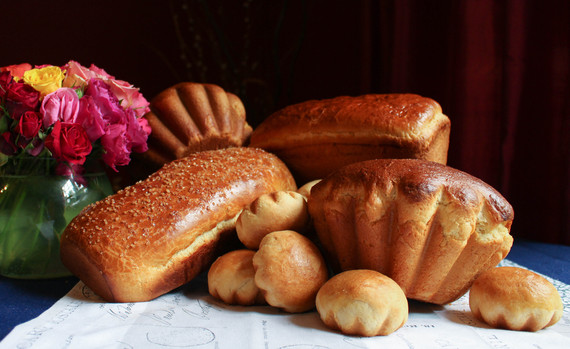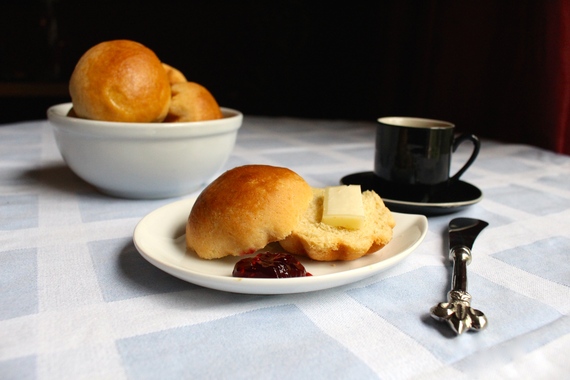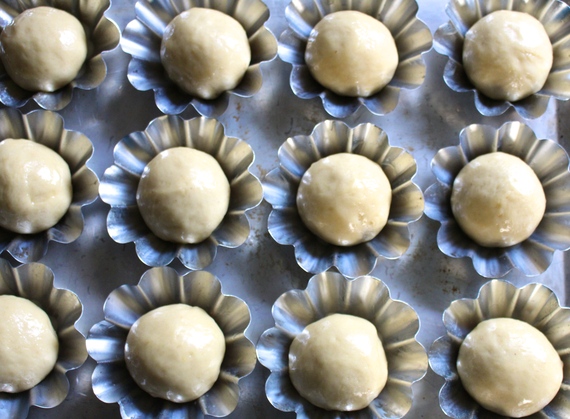Experimenting with brioche while developing my all natural line of Voilà! Hallah Egg Bread Mixes a few years ago led me to wonder: are 'hallah' and 'brioche' just two monikers for essentially the same bread? Is hallah bread brioche's poorer relative? I bake hallah regularly and, while I love brioche -- the heavenly French bread, rich with butter and a golden brown hue -- I rarely bake it. A time to celebrate freedom and democracy, the approaching Bastille Day gave me a noble excuse to bake up a storm.
Bastille Day ignited the French Revolution on July 14, 1789; it is historically acknowledged as the catalyst for the fall of monarchy and the rise of the modern republic. As the historical legend goes, the French Queen Marie Antoinette became immortal when she uttered, "Then let them eat cake," before her fateful appointment with the executioner at the guillotine. "Them" were the poor French people, starving due to bread shortages. It has been debated whether these words indeed passed through her lips. Whoever said it, though, apparently suggested they eat brioche, not cake, as the English translation misleads us to believe.
Investigating the roots of dishes conventionally considered 'Jewish food' fascinates me, which is not enough for me to claim the food historian title. Jews have resided in France since the early Middle Ages, where they had experienced expulsions and returns before the 18th century's Bastille Day. The French Revolution led to their emancipation and a grant of French citizenship. France now has the largest Jewish community outside of Israel and the USA.
Jewish and French cuisines are diametrically situated. The former with many restrictions imposed on the use of ingredients, flavors and their combinations, while the latter is abundantly limitless. Jewish food is essentially the local cuisine adapted to conform to the kosher dietary rules. Both, brioche and hallah, are enriched egg breads, albeit brioche is richer because it usually contains more eggs and a higher percentage of fat. Brioche is made with dairy ingredients, milk and butter, while hallah -- because of the prohibition to serving milk and meat at the same meal -- is nondairy.
So, is there a connection between hallah and brioche? Brioche is said to be an offshoot of a Norman bread recipe, which originated from Roman bread. Both brioche and Romanian sweet bread are prepared similarly and are traditionally served for holidays. Still today, different ethnic groups serve a version of a braided, sweet egg bread for special holidays, such as Easter and Christmas.
Hallah is so much a part of the Jewish Shabbat and holiday experience that we like to believe that it was part of our tradition forever. Not quite so. This yeasted, egg bread is only one variation of many such a bread. Hallah was adopted from the Germanic tradition and so were berches or barches, the names German Jews gave the braided Shabbat loaf. Apparently, women of Teutonic tribes invented braided German bread loaves. They originally offered their braided hair to their Goddess Berchta. With time, they offered braided loaves, as imitation of their hair braids, called berchisbrod or perchisbrod.
Also, most of us understand the Hebrew word hallah to mean 'portion,' for the commandment of separating a small piece of dough before baking the loaf. It was a symbol of the twelve loaves the Israelites made as an offering to the high priest in the temple before its destruction. Another, not as readily accepted, explanation traces hallah to the Judaization of Holle, one of the names of the German Goddess to whom pagans offered braided loaves. Offerings of sweet breads or cakes to goddesses and idols apparently date back to the Israelites, Ancient Egypt and the rest of the old world.
Serving hallah for Shabbat and holiday meals is now an established Jewish tradition, which originated from some European Jewish communities. They called hallah barkhes or barches. When the ch is pronounced like in Charlie, barches sounds a lot like brioche. All these descriptors are made from the root b.r.kh. The kh is a transliteration of the Hebrew letter khaf, which Ashkenazi Jews tend to transliterate as ch, like the Germans do. Substitute ch for the kh and you have bracha -- the Hebrew word for blessing - with the same root letters as in brioche. I favor the etymological connection I hear in these names - brioche and barches, the Goddess Berchta and bracha (blessing), but unsure about the connection between Goddess Holle and hallah. All these explanations hint to our shared beginnings before the stories of different people and their languages diverged.
Having baked many loaves of hallah and brioche, I can tell you that each is a singular kind of blessing. Brioche can be baked in many shapes - fluted, rolled, twisted and braided, a bun -- and flavors. The chocolate brioche is heavenly as is the bread pudding made with it. If you feel intimated by baking either from scratch, try this easy recipe with our Traditional Voilà! Hallah Egg Bread Mix. It would be a special treat any day, not just on Bastille Day.
Brioche Recipe
1 pouch bread mix from 1 box Voilà! Hallah Egg Bread Mix Traditional
1 packet yeast, enclosed
¼ cup warm water, 110° F
2 large eggs, room temp.
4 Tbsp. chilled butter, diced
Egg Wash:
1 yolk
1 tsp. water
For Pans:
1 Tbsp. unsalted butter, melted
For chocolate brioche:
8 oz. chopped chocolate or chocolate chips
Place the mix and yeast in the bowl of a stand mixer fitted with the hook attachment and stir. Add water and stir to combine. Add eggs and combine, then, add butter a bit at a time while the mixer is on. Mix the dough on medium-low speed for 10 minutes, stopping to scrape down the dough from the sides of the bowl and the hook, as needed. The dough will be smooth, elastic and a bit sticky.
Rub ½ tsp. melted butter all over a clean medium bowl (1.5Q/6 cup). With your greased hands, scoop the dough, gather into a ball, place smooth side down in the bowl and turn once to coat. Place in a warm, draft-free area to rest for 10 minutes.
Oil counter or board with 1 teaspoon melted butter or lightly dust with 1 teaspoon flour.
Buns: divide the dough into 12 equal pieces (about 50 g.), roll into balls and place in small buttered fluted brioche molds;
Fluted Molds: Shape into a ball and place in an 8" buttered fluted mold;
Loaf: place the dough on the board; press it gently with your palms and rolls into a loaf. Gently lift the dough and place it in a buttered or parchment-lined bread pan;
Chocolate Brioche: Roll the dough into a 12"x12" square. Sprinkle with chocolate and roll the dough away from you. Pinch the ends and lace seam down in a buttered or parchment-lined bread pan.
Let rise in a draft-free area for 1 hour or until doubled in size. Paint the tops of the breads with melted butter or 1 yolk diluted with 1 teaspoon of water. Sprinkle with coarse turbinado raw cane sugar, if desired.
Bake in the middle rack of a preheated 350° F oven:
Buns: 18 - 20 min.
Fluted: 35 min.
Pan Breads: 40 - 45 min.
The bread is baked when a toothpick inserted in its middle comes out clean. If not ready, bake for another 5 minutes and check again. Remove from the oven and place on a wire rack to cool. Wait 10 minutes before breaking.


